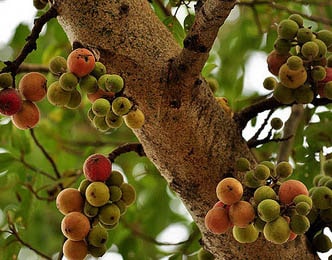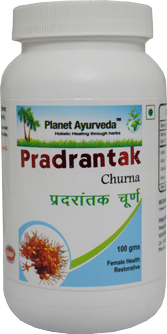Udumbara, Cluster Fig (Ficus Glomerata) - Practical Uses, Benefits, Dosage

Description of Udumbara or Audumbar Tree
Medicinal plants have great importance in the field of therapeutics, to treat various severe ailments. One of the medicinal plant known as Udumbara or Audumbar. Udumbara is known as Blue Lotus in Buddhism. The scientific name of the plant is Ficus glomerata. It is famous with the name of fig tree. This is an evergreen plant, parts of the plant are traditionally used as edible, fodder and ceremonial rituals.
Udumbara is a deciduous tree, can grow up to medium level up to a height of 10 to 16 meters. This is enriched with huge green foliage which provides good shade. The leaves of the plant are of ovate or elliptical shape. These are 7 to 10 cm long and has green colour. The leaves wither in December and flourish during January to April. Flowers of the plant are sheathed within the fruits as these are not visible differently. The fruits are edible and of pear shape. They grow in clusters arising from the main branch. These are 2 to 5 cm in diameter. The color of the raw fruit is green and becomes orange or dark crimson on ripening. Ripe fruit has a scented smell. The fruits are of smooth, subglobose or pyriform type and rarely covered with minute soft hairs. The seeds are so small, grain like and plenty in number. Bark is of greyish brown color, 0.5 to 1.8 cm thick, uneven with soft surface and cracked. The inner surface of the bark is of light brown color with fibers. It tastes like mucilage without any particular smell.
General Description
Udumbara or Ficus glomerata belongs to the Moraceae family. This is very famous herb, it is mentioned in various ancient scriptures also, like Udumbara is sacred to God Dattaguru as this tree is considered as kalpataru of kalayug, thus its trees can be seen commonly in the temple of God Dattaguru.
Udumbara is one of the lord Vishnu name. According to Vedas, Udumbara symbolizes good luck. It is also known as blue lotus in Buddhism.
This plant has several therapeutic uses in the traditional system. All parts of the plant are involved in medicinal cure. Leaves tend to cure bilious infections. Fruits are known to counter constipation and diarrhea. Bark of the plant cures dysentery, spongy gums, ulcers, diabetes, asthma, leucorrhea and urinary problems. With its traditional uses, Udumbara has many biological properties like antitussive, chemo preventive, hepatoprotective, anti-inflammatory, antidiuretic and antipyretic.
Parts of the plant contain no. of phytochemicals which are responsible for fighting with ailments. Roots of the plant contain euphorbol and its hexacosanoate, tinyatoxin, cycloartenol and taraxerone. Bark consists of elements like taraxerone, leucoanthocyanins such as leucocyanidin-3- O-β-glucopyranoside and leucopelarogonidin-3-O-α-Lrhamnopyranoside, euphorbol and its hexacosanate, β-sitosterol, ingenol, stigma sterol, lupeol, unidentified long chain ketone and ceryl behenate. Leaves of the plant contain glauanol acetate racemosic acid Tetra triterpene. Fruit consists lupeolacetate, β sitosterol, glauanol, higher hydrocarbons, glucose, hentriacontane, tiglic acid, phytosterol, esters of taraxasterol and friedelin. Latex of the tree contains euphol, a-amyrin, trimethyl, ellagic acid, tirucallol, euphorbinol, isoeuphorbol, tinyatoxin, taraxerol, cycloartenol, β-sitosterol 4-deoxyphorbol and palmitic acid.
Classification
- Kingdom - Plantae
- Subkingdom - Tracheobionta
- Superdivision - Spermatophyta
- Division - Magnoliophyta
- Class - Magnoliopsida
- Subclass - Hamamelididae
- Order - Urticales
- Family - Moraceae
- Genus - Ficus
Habitat
Udumbara grows all over the year in India. It is found in evergreen forests, deciduous forests and moist localities up to 1800 m above the sea level. It is cultivated over outer Himalayan ranges, khasia mountain, Punjab, Rajasthan, Chota Nagpur, Orissa, Karnatka, Kerela and Deccan plateau.
Names of the Udumbara
- Sanskrit name - Jantu phala, Jantukaphala, Hemadugdha
- Hindi name - Gular, dumar
- English Name - Crattock, Gular fig, Cluster fig tree, Country fig, Redwood fig
- Konkani name - Rhumbud
- Kannada name - Atti mara
- Malayalam name - Aththi
- Manipuri name - Heibong
- Marathi name - Udumbar, umbar
- Bengali Name - Dumur, udumbara
- Telugu name - Brahmamamidi, medi pandu, Attimaram
- Urdu name - Dumar
- Tamil name - Malaiyin munivan, utumparam
- Gujarati name - Goolar, umbaro
- Nepalese name - Dumrii
- Oriya name - Dimri
- Assamese name - Jagna Dimaru
- Thai name - Ma-Duer Uthumphon, Ma-Duer Chumphoni
- Simhalese name - Attikka
- Vietnamese name - Sung
Ayurvedic Properties
| Hindi / Sanskrit | English | ||
| Rasa | Kashaya | Taste | Astringent |
| Guna | Guru, Rooksha | Physical Property | Heavy, Dry |
| Virya | Sheeta | Potency | Cold |
| Vipaka | Katu | Metabolic Property (After Digestion) | Pungent |
Effects on Doshas
This plant balances doshas, as it increases kapha and helps to balance and reduce pitta.
Classical Categorization
| Charak Samhita | Sushruta Samhita | Vagbhata |
Kashaya Skandha - Astringent tasting group of herbs. |
Nyagrodhdi - Group of herbs is good for constipation, ulcers, thirst and vaginal diseases. |
Nyagrodhadi Gana - Group of herbs is good for constipation, ulcers, thirst and vaginal diseases. |
Mutra Sangrahaneeya - Group of herbs useful to restore normal quantity of urine. |
Ancient Verse of Udumbara

The Bhavprakash nighantu edition of 1998: verse 8 to 9, page no- 516 to 517.
It states that the Sanskrit names of Udumbara are udumbar, jantu phala, yajyanga and heimdugdhak.
Udumbara is sweet and astringent, cold in potency, dry and heavy in nature, helps in bone healing and manages pitta, kapha disorders and impurities of blood.
References
The Bhavprakash nighantu with elaborated Hindi commentary by Padmashri prof. K.C. Chunekar, edited by Dr. G.S. Pandey: Edition of 1998, verse 8-9, page no. 516 to 517.
Practical uses of Udumbara
Udumbara plant shows certain medicinal properties such as chemoprotective, hepato-protective, antipyretic, anti-inflammatory, anti-bacterial, anti-fungal and many more.
Udumbara in fever
- As Udumbara is enriched with properties like antipyretic and anti-inflammatory, helps to treat the condition of fever.
- Just take fresh Udumbara root and make its juice. Take up to 9-10 grams of this juice with sugar twice a day, in the morning and evening.
- Take 10 to 20 gram Udumbara bark and soak it in 400 ml water. Strain this after three hours. Take this infusion up to 50 ml in the morning and evening.
Udumbara in Piles and fistula
- Take 14-15 gram leaves of Udumbara and make its powder. Mix this powder with 250-270 gram add curd, black salt and consume it two times a day in condition of piles. The preferable choice for curd will be prepared from cow milk.
- Take 15-20 drops of Udumbara plant milk secretion and mix this in water and drink. This show great effects in state of bleeding during piles.
- To cure the problem of fistula, take some milk secretion of Udumbara plant and dip cotton in it. Now place that cotton piece on fistula every day.
Udumbara in Urinary disorders
- To treat urinary problems take 10-11 drops of Udumbara milk secretion in two batashas (a kind of sugar sweet) every day.
- In the state of yellow urine, take the fruits peel, dry and grind it. Mix equal amount of sugar in it and consume up to 6-7 gram with cow milk, two times a day.
- To cure internal wounds in urinary organs, take Udumbara plant up to 50 grams and 1-2 gram camphor. Make its decoction and rinse the organs.
- In polyuria, take the Udumbara unripe fruit powder with equal amount of sugar. Consume 7-10 grams with milk or water.
Udumbara in Hemorrhagic diathesis
- It is a condition in which there is excessive bleeding due to deficient coagulability of blood due to the problem of coagulopathy. To treat this problem one can take 30 gram bark of Udumbara, make its paste and apply on the inner side of upper jaw. This is great for the treatment of nasal bleeding.
- Consume 3 ripe fruits of Udumbara with sugar three times a day to stop bleeding.
- To stop blood during vomiting, take fruits of Udumbara, make its powder and consume up to 4-5 gram of this powder with milk, three times in a day.
- To cure metrorrhagia, abortion, excess bleeding and diarrhea with bleeding, take unripe Udumbara fruit and sugar. Make its powder and consume 5-7 gram with water in the morning and evening.
- In the case of diathesis and bleeding during diarrhea, make the juice of its leaves and consume up to 5 ml of its juice with honey.
Udumbara in Leucorrhea
- Take out Udumbara juice and consume 10 ml juice by adding sugar in it twice a day.
Udumbara in Dysuria
- Consume up to 3 fruits of Udumbara early in the morning.
Udumbara in After conceiving
- To boost up the growth and protection of fetus from abortion, take one fruit of Udumbara and blend it with milk and consume with meals.
Udumbara in Ulcers and udumbara
- Take some seeds, soak in milk and then grind it. Now apply this paste up to 15 grams on the ulcers.
Udumbara in Aphrodisiac
- Take the powders of Udumbara fruits and Indian kudzu fruits. Take this powder up to 6 grams with milk add ghee and sugar. Consume twice a day.
- In men, it enhances potency and sexual power.
- In women, it cures all aphrodisiac problems.
Udumbara in Gonorrhea
- In the early state of this disease, consume powder of unripe fruits of Udumbara with sugar up to 6 grams.
Other indications
- Anti-bacterial - show effect on Bacillus subtilis, Pseudomonas aeruginosa, Escherichia coli, Staphylococcus aureus and Bacillus pumitis.
- Anti-fungal - It has antifungal activity also.
- It is hepato-protective also.
Audumbar Parts Used
- Bark
- Fruits
- Latex
Dosage
- Powder - 3 to 6 grams
- Decoction - 50 to 100 ml
- Latex - 5 to 100 drops
Things to be kept in Mind
Use precaution in using Udumbara if one suffers from cough, cold and allergic reactions. It can be safely used in pregnancy.
Ayurvedic Products from Udumbara by Planet Ayurveda
Pradrantak Churna
Pradrantak Churna is a complete herbal formulation to take care of female health problems. It is particularly effective in painful menstruation, pre-menstrual syndrome (PMS), irregular menses, uterine fibroids, ovarian cysts and leucorrhoea. This herbal powder is a slight modification of classical Ayurvedic formula "Pushyanug" churna. The herb Saraca indica naturally balances disturbed female hormones.




